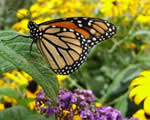 Go to main content
Go to main content
Archive Website of the UK government
Please note that this website has a UK government accesskeys system.
Main menu
Page menu
Environment and greener living

Protecting the environment: a quick guide

Simple, everyday actions can help protect the natural environment and conserve biodiversity (the variety of life on earth). Find out what you can do – from creating a space for wildlife to disposing of waste carefully, and from volunteering to recording wildlife.
Why protect the environment?
The natural environment underpins the health of the planet and is a vital part of the world’s economy. However, human activity is causing an increasing decline in biodiversity (the variety of life on earth).
More people need to take action to tackle the decline in biodiversity and protect the environment. The ten tips below show you easy, everyday activities that can help.
1. Create a space for wildlife
Create and encourage others to create, wildlife-friendly spaces at home, in your local community and through work. Simple actions can make a huge difference. For example:
- put out food and water for garden birds
- plant native trees and wild flowers
- make or buy a bee box to help bees survive the winter
- let a bit of your garden grow wild to create your own wildlife haven
Natural England and Buglife have more ideas, and you can read about making your garden wildlife friendly in ‘Encouraging wildlife in your garden’.
2. Enjoy the natural world where you live
Enjoy – and value – your local outdoor spaces and share this enjoyment with others. Find local parks and green spaces using the link below.
3. Volunteer
Volunteers already do a great deal to conserve biodiversity and protect the environment. Volunteering to improve your local environment is fun, healthy and free. You can find conservation volunteering opportunities on the Muck In4Life website, or by looking for community groups near you.
4. Take part in a wildlife survey
Get involved in a wildlife survey. This involves recording the wildlife you see and sending the results to citizen science projects or your local records centre.
5. Support a wildlife or conservation group
Join or support an organisation working to protect wildlife and the natural environment. You could give your time or money to help their efforts. Wildlife and Countryside Link is an umbrella body that brings together many of these organisations in one place.
6. Make your voice heard
Use your civic power and make sure that those who represent you, like your MP, reflect your concerns about the environment.
7. Be Plant Wise
When you are clearing out old pond plants, remember to compost them carefully.
Some pond plants can become a problem if they get into the wild. They can smother native plants, clog waterways, worsen flooding and remove oxygen from the water, which can harm fish.
8. Think before you buy
Some gifts and foods available in certain countries can be made from endangered plants or animals. Think before you buy wildlife-based products or souvenirs from overseas trips. If in doubt, it’s best to avoid them.
When buying products, from foods to furniture, there is often a greener choice. Look out for labels like:
- the Marine Stewardship Council (MSC) label for fish
- the Forest Stewardship Council (FSC) label for wood products
Only buying peat-free compost to use in your garden can help to protect important peat bogs.
9. Dispose of waste carefully
When it's time to throw something away, make sure you dispose of it carefully and safely.
Never pour paints, varnishes or waste pesticides down the drain or put them in household bins. This can lead to hazardous chemicals getting into the environment. Your local council can give you advice on safe disposal. For more information, see the paragraph ‘Disposing of paints, finishes and preservatives’ in ‘Greener DIY’.
Many electronic items contain chemicals that can damage natural systems if not disposed of properly. For more on how to safely dispose of these, see ‘Reusing and disposing of electrical equipment’.
10. Reduce waste
Everything you buy has some impact on the environment, because it takes energy, water and resources to make it. Trying not to waste things can help, as it means you need to buy less.
For example, you could:
- cut down your food waste by making use of your leftovers
- hang on to your mobile phone for longer and recycle old handsets
- avoid excess packaging
- take your own bags when you go shopping
 Facebook
Facebook Twitter
Twitter StumbleUpon
StumbleUpon Delicious
Delicious Reddit
Reddit